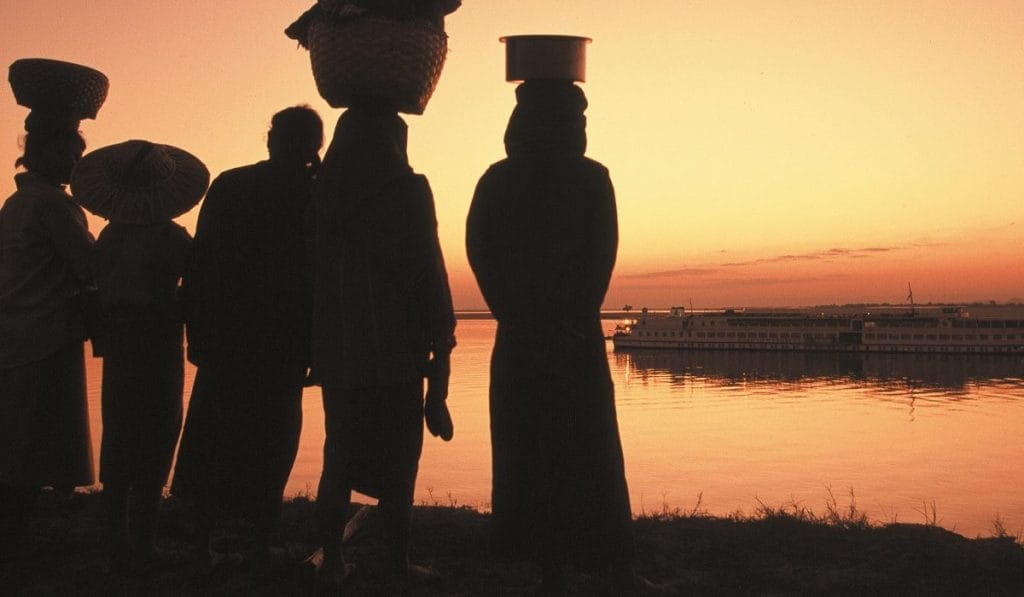I’ve done my fair share of meditating – at home in bed, in front of an altar or occasionally in a taxi before succumbing to slumber. But sitting cross-legged in a small 12th century Buddhist temple gazing out at Myanmar’s green farmlands? That’s unprecedented. Not least because I had to cycle for 30 minutes along waterlogged mud paths through Old Bagan in the country’s former capital of Mandalay to get here.
The Ywa Huang Gyi temple is far off the beaten track, so its surroundings are serene and undisturbed by tourists. Though obviously old, it is far from decrepit, its upkeep carefully maintained by devout Buddhists from nearby villages. The spot was carefully chosen by yoga and meditation teacher Brian Hilliard, who had, prior to this session, scouted for ideal places along the Ayeyarwady River to practice calm.

TEMPLE RUN Bagan holds a staggering 2,000 over temples, some of them dating back to the 9th century.
Hilliard is a guest teacher on the Belmond Road to Mandalay mindfulness cruise that offers yoga and meditation sessions alongside excursions around Mandalay. Now based in Europe, the 56-year-old American has conducted mindfulness retreats in Morocco, Greece and Italy in a career that spans over 35 years. Although this is his first time in Myanmar, he declares that he has never felt more at home.
“There’s an atmosphere in Myanmar that makes it easy for people to practise meditation,†he says. “People here are kind and hospitable.â€
Onboard, Hilliard guides guests through a condensed course of Tibetan yoga, a series of fast paced and pain-free movements. It’s not as graceful as the body-bending Hatha yoga, but the energy required is sufficient to work up a sweat.
Fast or slow, practised on the vessel with the green fields along the Ayeyarwady sliding by or in villages surrounded by farmland, the mindfulness programme intrinsically embeds guests in the country’s milieu. The religious roots of the practice gel with the over 2,000 stupas and temples dedicated to Buddha that populate the Bagan Archaeological Zone.

Meditation in Myanmar is practised as part of Buddhist teachings.
Here, religious traditions remain very much a part of daily life. Monks – some as young as five years old – still go to the temple at dawn, rain or shine, to receive from villagers their portions of rice and fried fish in their alms bowls, their first and only meal of the day.
Says Samantha Strawford, Belmond’s global brand communications director: “These well-being experiences are created to reflect the authentic culture of each location, leaving guests with a renewed sense of clarity and calm, while deeply connecting them to the destination.â€
Introduced in 1995, The Road to Mandalay was considered a pioneer in the niche luxury bracket. Plying the waters between Shwe Kyet Yet village and Bagan, the vessel bore witness to the country’s transition from a military regime to democracy.
The Belmond Road to Mandalay is one of Myanmar’s first luxury cruises and has been plying the Ayeyarwady River for 22 years.
Like the pace of the cruise, developments are slow but steady. The lack of infrastructure and unstable political conditions left Myanmar a less popular tourist destination than its neighbours, Thailand and China. But now, the shiny yellow pagodas that gave the country its nickname “The Golden Land†are as likely to be framed by scaffoldings and towering cranes as lush forests.
Even in the ancient sites of Bagan, change is inevitable – though for the best. While often compared to Cambodia’s Angkor Wat, Bagan is still unblemished by mass tourism. The government has expressed interest to better preserve the sites, and climbing up the structures may be banned for good in the near future.
“You won’t be able to see the country like this soon,†says a tour guide from the cruise. Culture will evolve as well, he predicts, and points out that his longyi, a unisex skirt still worn by the Myanmar young and old, may soon go out of style and be replaced by Western clothing.
Thinking back of my sodden journey through Old Bagan, it’s not hard to see how Myanmar can benefit from change. But, like all developing nations, the question is how to move forward without losing sight of its roots.


